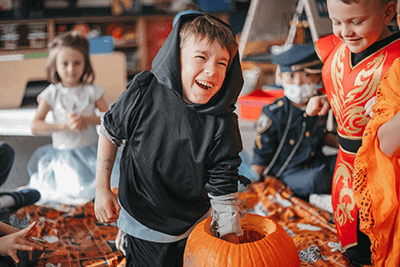November 2, 2023
 from Bill Hudson, head of school
from Bill Hudson, head of school
We had a marvelous turnout for Grandparents and Special Friends Day with more than 450 guests. I received a handwritten thank you note from a grandparent that expresses much of what I heard from multiple grandparents/special friends throughout the day. It read, “It truly was a morning to remember. My grandchildren are thriving at MPA, and it is easy to see why—the nurturing, caring, high-standard environment you and all the teachers and staff have created was a joy to behold.”
Joy isn’t always associated with education. In an era of emphasis on high-stakes testing, rote learning, and fears about falling behind academically, the importance of joy in education is often overlooked. Or worse, students working (occasionally laughing) together on a project, joyfully carving a pumpkin, excitedly creating a play from scratch, singing with gusto, or delighting in the music they create from their musical instrument isn’t considered “real learning.” What is real, however, is the declining mental health and increased anxiety our children are experiencing, which is being called the “crisis of our times” by United States Surgeon General Vivek Murthy.
“The truth is that when we scrub joy and comfort from the classroom, we distance our students from effective information processing and long-term memory storage,” Dr. Judy Willis wrote in the “Neuroscience of Joyful Education”. “Instead of taking pleasure from learning, students become bored, anxious, and anything but engaged. They ultimately learn to feel bad about school and lose the joy they once felt.” Neuroimaging studies and measurement of brain chemical transmitters have demonstrated that when students are emotionally invested in their learning, they are more likely to remember and apply what they have learned. Joyful experiences create positive associations with learning, making it more likely that students will continue seeking knowledge beyond formal education’s confines.
Education is not only about academic achievement but also about the holistic development of individuals. Joy in education contributes to the overall well-being and mental health of students. It reduces stress and anxiety levels, enhances overall satisfaction with the learning process, and promotes a positive outlook on personal growth and development.
Joyful learning spurs creativity and critical thinking. Engaged and enthusiastic students are more likely to think outside the box, ask probing questions, and seek innovative solutions. This kind of intellectual curiosity is the bedrock of innovation.
Halloween at MPA is an excellent example of joy in action. Last Friday, the Middle School Student Council continued the tradition of hosting a Halloween party for fifth and sixth graders and a dance for seventh and eighth graders. This Tuesday, our wonderful Parents Association treated Lower School students to a magical Halloween Party.
At the end of the day, Middle and Upper School students, along with faculty, staff, and parents, lined the main hallway as Lower School students jubilantly marched through the school, proudly donning their costumes for the annual Halloween Parade. Cheers, high fives, laughter, and smiles abounded.
Creating and nurturing a joyful learning environment is at the heart of MPA. Whether in or out of the classroom, through annual traditions and special events, joyful learning is intentional. Fourth-grade teacher Deedee Stacy put it this way, “As a community, we recognize joy when others might only see daily occurrences. Tying a shoe? Losing a tooth? Joy. An opportunity for an Upper School student to lift a Lower School child up to get a drink? Offering a hand to a classmate who is hesitant to walk into the commons? Joy. We see it because our students and families bring it into the building with them as a matter of course. We are lucky to be in an environment that recognizes the beauty everyday.”